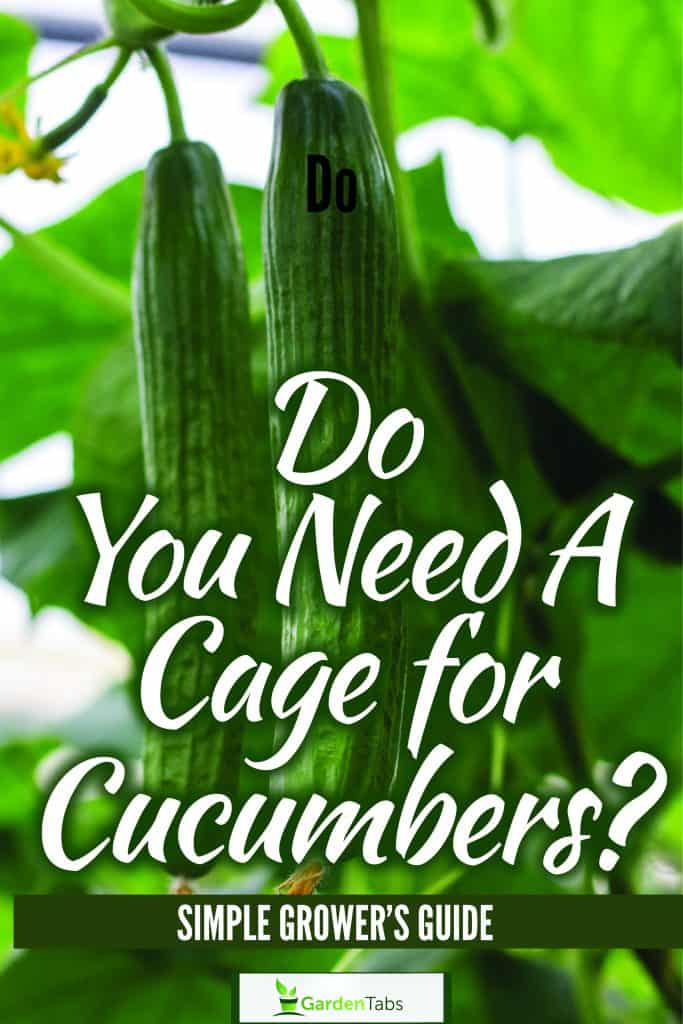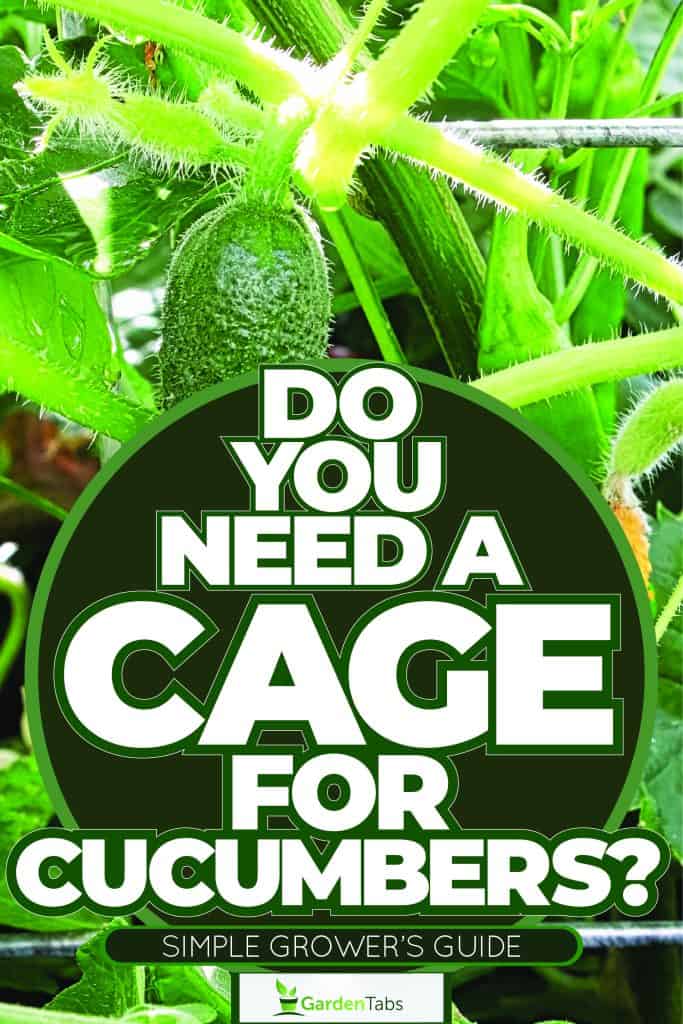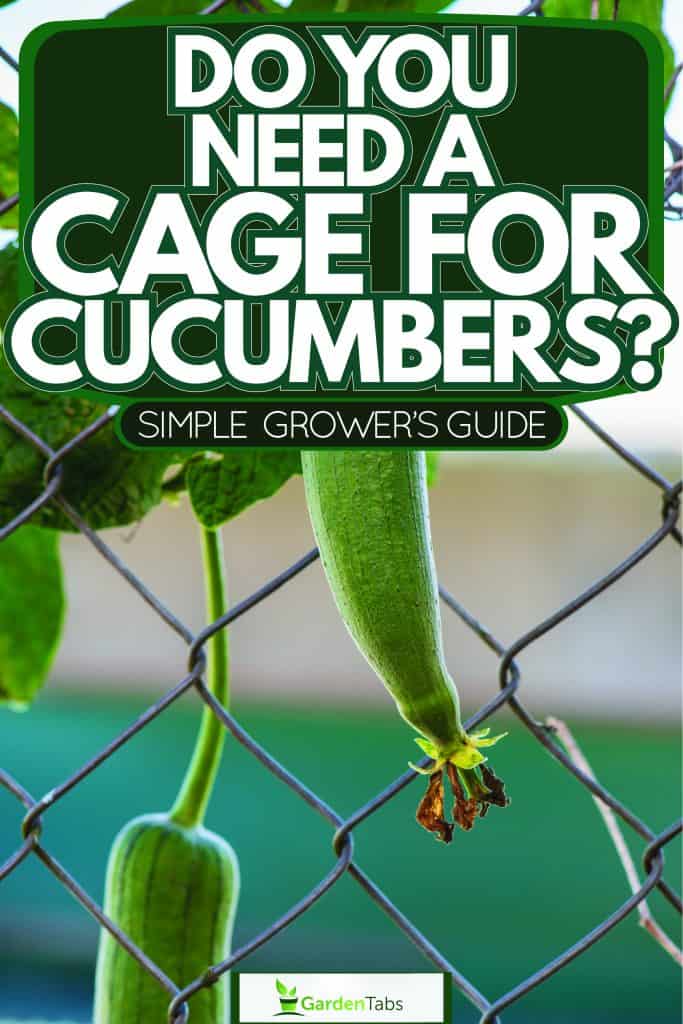Cucumbers are a favorite amongst gardening enthusiasts because they are easy to grow in a short amount of time and give great yield.
As you venture into the world of growing these versatile vegetables, you might be wondering if you need a cage for cucumbers.
It turns out that the type of cucumbers you choose to grow impacts the necessity of a cage.
If you're diving into vining cucumbers, you'll need a minimum of 8-10 feet of vertical space for them to thrive.
In that case, a cage of similar height would be ideal.
Bush cucumbers, on the other hand, can also benefit from an 8-10 feet tall cage, but they aren't as dependent on having one.
So, in a nutshell, while a cage can help your cucumbers grow vertically and manage their space, it's not always a must-have.
It depends on the kind of cucumbers you're growing and the space you have available.
Stick around to learn more about how to give your cucumber plants the best support they need to flourish in your garden.
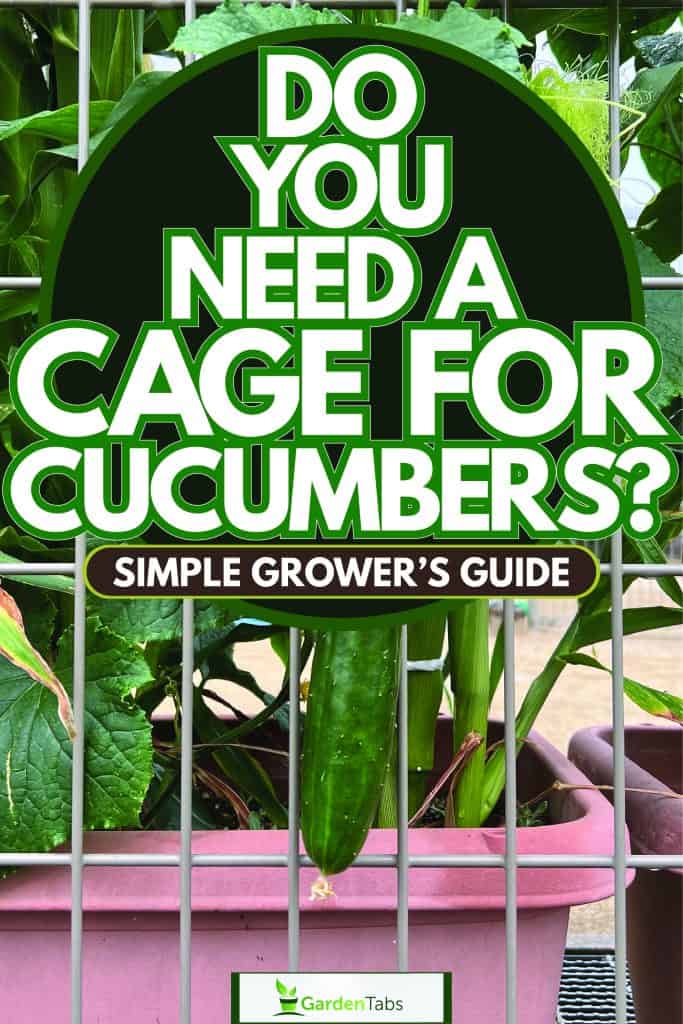
Why Use a Cage or Support for Cucumbers
Your cucumbers will thank you for providing them with the support they need to grow healthy and strong, and here are the reasons why:
Improved Air Circulation
Providing a cage or support for your cucumber plants can greatly improve air circulation around them.
This helps keep the foliage dry, reducing the risk of fungus and disease.
Cucumber vines are excellent climbers and will naturally grow on cages or supports, allowing their leaves to spread out and catch more sun.
This leads to healthier, more productive plants.
So, by giving your cucumbers a structure to cling to, you're not only helping them grow strong, but you're also promoting a healthier garden.
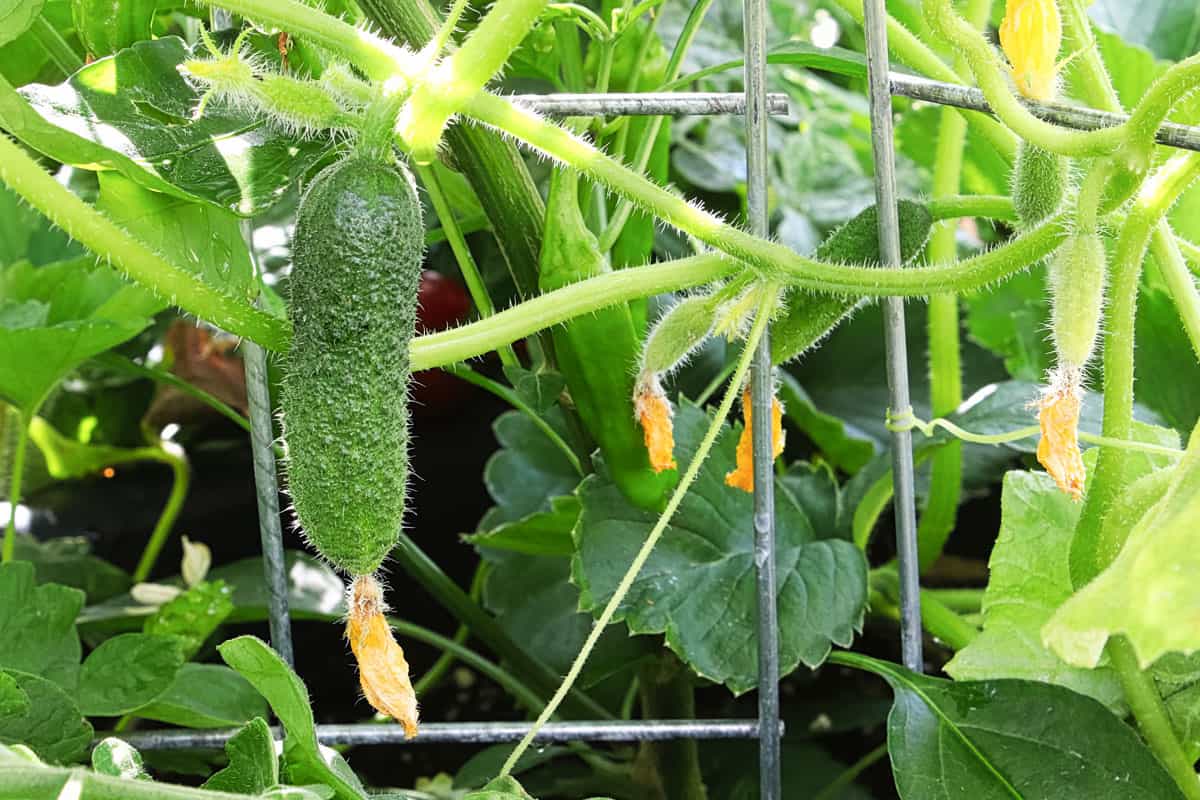
Increased Harvest Yield
Cucumber plants that are grown upward with cages or supports are more likely to produce a higher yield.
This is partly due to the improved air circulation and access to sunlight.
Additionally, when cucumbers are grown vertically, they're less likely to be damaged or rot from sitting on damp soil.
Growing cucumbers vertically with a support system also makes them easier to spot and harvest, ensuring that you don't miss any hidden treasures among the foliage.
Pest and Disease Prevention
Using a cage or support can help keep cucumber plants off the ground, which discourages pests and diseases from attacking them.
Many common garden pests, such as slugs and snails, are less likely to reach cucumbers that are growing vertically.
Similarly, when cucumber foliage is away from the ground, it is less vulnerable to soil-borne diseases.
By providing a support system for your cucumber plants, you're investing in a healthier, more productive garden.
Types of Cucumber Support Systems
Growing cucumbers can be both fun and rewarding, particularly when you provide the proper support to help them thrive.
Cucumber Cages
Cucumber cages are a practical option for giving your plants the support they need.
A popular choice is to repurpose a tomato cage for this purpose, as it provides ample room for the cucumber tendrils to latch onto and climb.
Cages are beneficial because they keep the cucumbers off the ground, reducing the risk of rot and making them easier to harvest.
Try these heavy duty thick galvanized steel plant cages on Amazon.
Stakes and Twine
Another simple yet effective support system is using stakes in combination with twine.
Drive stakes into the ground at intervals, then run the twine between them horizontally, allowing the cucumber plants to climb along the string.
The stakes provide stability, while the twine offers a good gripping surface for the tendrils.
This method is both cost-effective and adaptable to any garden space.
Read more about it here: Do You Need To Stake Cucumbers? Essential Tips For Better Yield
Trellis
Utilizing a trellis can be a stylish and efficient way to support your cucumber plants.
Trellises come in various materials such as wood, metal, and bamboo with different designs that can complement your garden's aesthetic.
They provide ample space for the cucumber vines to grow vertically, keeping them off the ground and making harvesting more manageable.
More info on trellises here: Do Cucumbers Need A Trellis?
A-Frame Trellis
An A-frame trellis provides sturdy support while taking up minimal ground space.
With two triangular frames connected at the top and horizontal bars in between, the A-frame trellis can hold several cucumber plants, producing a lush green wall.
This design is perfect for small gardens or patios.
Get this easy-to-install cucumber trellis on Amazon.
Vertical Support
Lastly, consider using vertical supports such as fences, walls, or even existing structures in your garden to grow cucumbers upward.
Attach a lightweight trellis or netting to the chosen vertical surface, and let the cucumber vines latch on and climb.
This method optimizes garden space and adds a unique, decorative touch to your outdoor area.
Remember, providing the proper support system for your cucumber plants can make all the difference in promoting their health, growth, and ease of harvesting.
Choose the support option that works best for your garden and meets your needs, and watch your cucumbers flourish.
And if you're staying on a budget, you can always build your own support system like in this video below:
Choosing the Right Support for Your Cucumber Variety
When it comes to growing cucumbers, the type of support you choose can have a significant impact on the health and productivity of your plants.

Bush Cucumbers
Bush cucumbers are compact plants, growing in a more contained manner compared to their vining counterparts.
Since they don't climb as much, they generally don't require an extensive support system.
However, a small tomato cage or cylindrical wire support can be beneficial in keeping the fruit off the ground and preventing potential issues with pests or diseases.
When selecting a support for your bush cucumbers:
- Choose a small-sized cage or wire support that's easy to install and maneuver.
- Ensure the structure is sturdy enough to withstand the weight of your plants and the cucumbers they produce.
Vining Cucumbers
Vining cucumbers grow more aggressively, with tendrils that reach out to latch onto supports for stability as they climb vertically.
Providing an appropriate support system, such as a trellis, is essential for managing their growth and ensuring a healthy harvest.
When choosing the right support for your vining cucumbers:
- Opt for a sturdy trellis made of wood, metal, or wire mesh.
- Consider a structure that's easy to dismantle for storage, like an A-frame or vertical trellis.
- Make sure your support is tall enough to accommodate the full height of your plant variety, typically between 4-6 feet.
Kitchen Garden Cucumbers
If you're growing cucumbers in a small kitchen garden or even in containers, space-saving support systems are vital.
Wire cages, such as tomato cages, can help keep your cucumber plants contained within a limited area without restricting their growth.
For planting cucumbers in a kitchen garden, consider the following tips:
- Select a support that's an appropriate size for your garden or container, such as a 12- to 18-inch-diameter wire cage.
- Ensure the structure is easy to install and transport, in case you need to move your plants around your garden space.
- Consider using a net or plastic tunnel to protect your plants from pests while still allowing access for pollinators.
Preparing the Garden for Cucumber Plants
Selecting the Right Soil
To give your cucumbers the best chance for success, you'll want to choose a well-drained garden soil that has a slightly acidic pH between 6.0 and 6.5.
To prepare the soil, you can add 2-3 inches of rich high-quality organic compost. This will enrich the soil and improve overall drainage.
Creating a Nutrient-Rich Base
Once you've selected the right soil, it's time to create a nutrient-rich base for your cucumber plants.
To do this, loosen the lower layers of soil using a broad fork, and use a rake to smooth out the surface.
You'll want to ensure that your garden has ample organic matter and aeration, as cucumbers thrive in raised beds with lots of organic matter.
Planting Cucumbers at Proper Temperatures
Cucumbers grow best in warm weather.
To get a head start on the season, you can start seeds indoors in late April for transplants, or sow seeds directly in the garden once the soil has warmed, usually in May.
Ensuring consistent moisture is essential, so remember to water your cucumber plants early in the morning, as this is the best time to avoid any potential foliage damage caused by the sun's rays.
DIY Cucumber Support Ideas
Let's explore some budget-friendly DIY cucumber support options that you can easily create at home.
PVC Pipe Trellis
One great option is using PVC pipes to create a trellis for your cucumbers. This lightweight, inexpensive material allows you to build a durable, weather-resistant structure.
To create a PVC pipe trellis:
- Cut and connect PVC pipes to create a stable frame.
- Add connectors, if needed, to create corners and crossbars.
- Attach a garden net or lattice to the frame for the cucumbers to climb.
Bamboo and Garden Twine
You can also create a bamboo trellis using bamboo stakes and garden twine. This natural option is both budget-friendly and eco-friendly.
To build a bamboo trellis:
- Gather at least thee bamboo stakes for each cucumber plant and secure them in the ground, forming a teepee-like structure.
- Wrap garden twine around the stakes at several heights, creating horizontal support for the cucumbers to climb.
Cattle Panel Arches
Cattle panels can be transformed into a sturdy cucumber arch trellis. Their strong, durable design will provide plenty of vertical support for your cucumber plants.
Creating a cattle panel arch trellis:
- Secure the panel edges to the ground, leaving enough space for plants to grow.
- Bend the panel into an arch and secure the other edge, forming a tunnel.
- Plant cucumbers on both sides of the arch, allowing the vines to climb up and over the panel.
Wood Ladder
Building a wood ladder trellis combines a classic, rustic look with functionality for your cucumber plants.
To create a wood ladder trellis:
- Build an A-frame structure using wooden stakes or recycled pallet wood.
- Attach horizontal crossbars to the stakes, creating ladder-like rungs for cucumber vines to climb.
- Secure the entire structure in the ground, and plant cucumbers at the base of the ladder.
With these creative, budget-friendly options, your garden will have the perfect support system for growing healthy, bountiful cucumbers.
Caring for Cucumber Plants on Supports
Here are some key aspects of tending to supported cucumber plants.
Guiding and Wrapping the Vines
As your cucumber plants start to grow, it's important to help guide the vines onto the support system.
Gently encourage the tendrils to wrap around the structure, whether it's a trellis, cage, or stake.
Be gentle while handling the vines and ensure they're securely fastened to the support without damaging the plant.
This process helps your cucumber plants grow vertically and keeps them off the ground, reducing the risk of pests and diseases.
Learn more from this video below:
Monitoring and Maintenance
Your cucumber garden requires regular monitoring to ensure optimal health and growth.
Check the plants for any signs of pests or diseases, such as yellowing leaves or spots on the fruits. Remove any affected portions to prevent the spread of infection.
In addition to this, inspect your support system to make sure it remains sturdy and strong as the plants continue to grow.
Fix any loose or damaged sections to prevent the structure from collapsing and damaging your precious cucumbers.
Harvesting the Fruits
As your cucumber fruits start to reach their ideal size, it's time to harvest them.
Supported plants make the harvesting process much easier because the fruits are more visible and accessible.
Use a clean, sharp pair of scissors or garden shears to gently cut the cucumber from the vine, taking care not to damage the plant or other fruits.
Harvest your cucumbers regularly, as this encourages the plant to produce more fruits.
Keep an eye on their growth, and don't let cucumbers become overly ripe or too large, as this can impact the taste and texture.
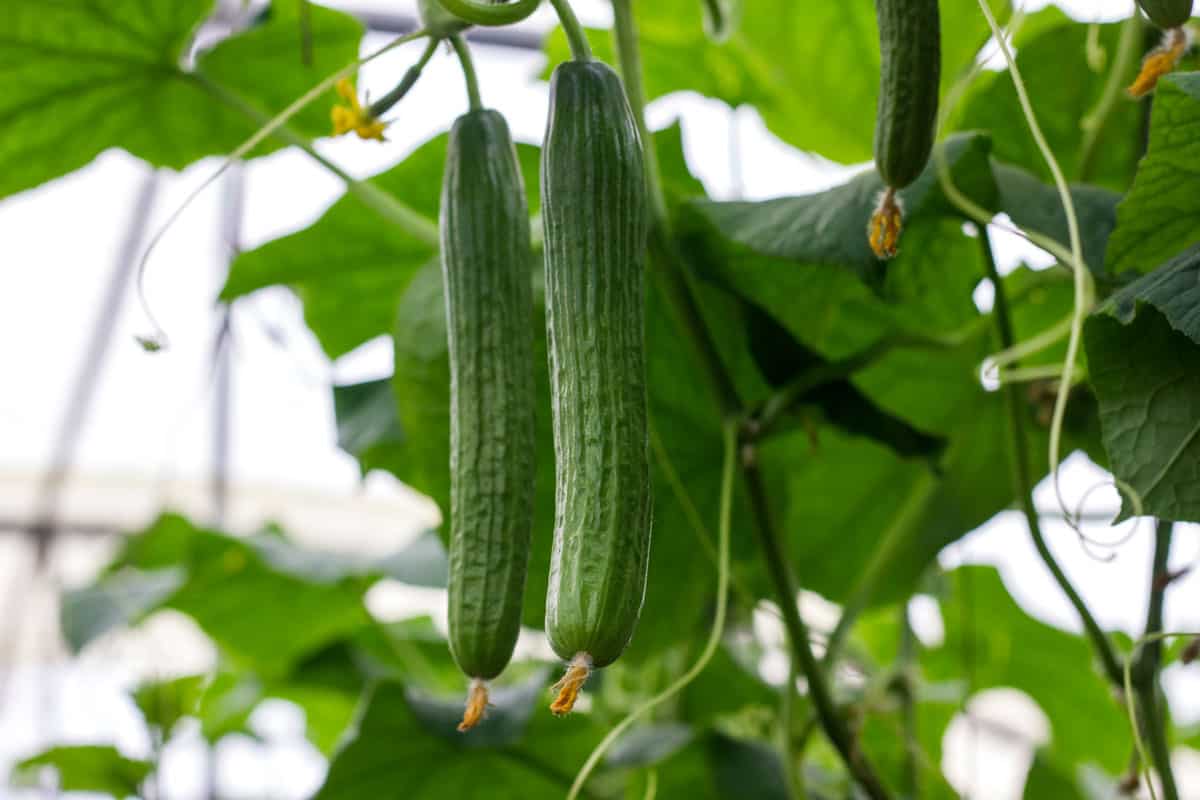
Train Them While They're Young
In the end, deciding whether or not to use a cage for your cucumbers depends on the variety you are growing and the space you have available.
It's crucial to train your cucumber plants to climb the cage or trellis as they grow.
This way, you'll make the most of the support system you've installed and encourage healthier, more productive plants.
Have you tried caging your plants? How did it go? Tell us in the comments! And while we have your attention, learn how to get rid of cucumber pests here: What Is Eating My Baby Cucumbers [And How To Prevent It]?


